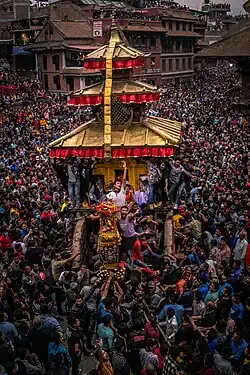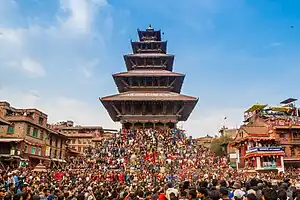| Biska Jatra 𑐧𑐶𑐳𑑂𑐎𑐵𑑅 𑐖𑐵𑐟𑑂𑐬𑐵 | |
|---|---|
 | |
| Genre | Festival |
| Dates | 14 April (13 April on leap years) |
| Frequency | Annual |
| Location(s) | Bhaktapur District |
| Country | Nepal |
| Activity | Religious |
Biskā Jātrā (Newar: 𑐧𑐶𑐳𑑂𑐎𑐵𑑅 𑐖𑐵𑐟𑑂𑐬𑐵, biskāḥ jātrā), also known as Bisket Jatra (Nepali: बिस्केट जात्रा) refers to an annual festival celebrated in April at Bhaktapur, Thimi and their environs.[1] In many of the places where it is celebrated including Bhaktapur and Thimi, Biska acts as the main celebration of the year. Biska unlike other Nepalese festivals is based on the solar calendar instead of a lunar calender.[2]
The name Biska encompasses festivals celebrated around the same time in Bhaktapur, Thimi, Bode, Nagadesh, Dhapasi, Tokha, Dhulikhel, Katunje, Gundu and Sanga.[1] Biska originated as festival celebrating the March equinox and the Solar New Year in Bhaktapur.[2] During the Malla dynasty, many new traditions were added, including the chariot festival of Bhairava and his consort Bhadrakali in Bhaktapur, the sindoor throwing festival in Thimi, both of which constitute the most iconic part of the festival today.[3]
Etymology
The contemporary name of the festival in Nepal Bhasa, biskāḥ, originates from the Classical Newar term biskyāta (𑐧𑐶𑐳𑑂𑐎𑑂𑐫𑐵𑐟).[3][4] This classical term, "biskyāta" is a compound of two elements, "bisika" (or "bisaka") and "ketu", where bisika denotes the March equinox in Classical Newar, derived from its Sanskrit name viṣuvad which is also the etymological source of Vaisakha.[2] Concurrently, 'ketu,' a Sanskrit loanword signifying 'banner' contributes to the formation of 'biskyāta'.[3][5] The designation jātrā (𑐖𑐵𑐟𑑂𑐬𑐵) finds its roots in the Sanskrit yātrā (यात्रा), meaning 'journey' or 'procession'. In Nepali, the festival is referred to as Bisket Jatra, a Nepali adaptation of the indigenous term "biskāḥ jātrā".[3]
In local legends, the name biskāḥ (𑐧𑐶𑐳𑑂𑐎𑐵𑑅) is believed to be derived from combination of two Newar words, bi and sikā which when combined with jātrā means "festival commemorating the death of serpent".[3][6]
Origin
Legend has it that this celebration is the "festival after the death of the serpent". Various areas of Bhaktapur city celebrate this festival according to their own rituals. The most eventful places are Taumadhi Square and Thimi Balkumari. A chariot carrying the statue of Lord Bhairava is pulled by hundreds of people to towards upper (Thaney) and lower (Koney) neighbourhood as tug of war. Approximately a month earlier, the chariot is assembled near the Nyatapola temple.
Observations

The signature event on Bhaktapur Taumadhi kicks off the Biska jatra "dya koha bijyaigu" which means the god Bhairava is brought outside from its temple for the festival, it is a tug-of-war between the Thane (upper) and Kone (lower) part of town. The chariot is pulled from both sides and whoever wins that part of town gets to take the chance of the chariot to their place while the other sides wait for their turn. The chariot is at last pulled down to gahiti where the chariot is kept for two days and again pulled down to Lyasinkhel on the eve of Nepali new year.
An approximately 25 meter Yoh si Dyo is erected in the yosi khyo. The chariot is then pulled on the Lyasinkhel and kept till the next day. The Yoh si is pulled down on the eve of New Year. Then again the chariot is pulled to gahiti and on the last day which is also called " dya thaha bijyaigu" which means god Bhairava is again brought to temple,all the people are, the chariot is again pulled on both sides and finally settled to the premises of 5 storied temple.
Several places in Madhyapur Thimi (Thimi, Nagadesh and Bode) also celebrate Biska Jatra. Folks from various parts of Madhyapur Thimi gather, carrying their own chariots in Layeku Thimi. People celebrate and share greetings, throwing simrik color powder and playing Dhimay music.
Bode witnesses a tongue-piercing ceremony. One resident spends the whole day with an iron spike piercing his tongue and roams the city by carrying multiple fiery torches on his shoulder. Juju Bhai Shrestha is the most renowned tongue piercer town.[7][8][9]
See also
References
Citations
- 1 2 "बिस्का जात्राको संस्कृति र इतिहास". Majdoor (in Nepali). 13 April 2022. Archived from the original on 19 November 2023.
- 1 2 3 Vajracharya, Gautama Vajra (6 November 2018). "Nepal Saṃvat and Vikrama Saṃvat; Discerning Original Significance". Asian Art. Archived from the original on 20 November 2023.
- 1 2 3 4 5 Shrestha, Purushottam Lochan (13 April 2020). "biksah bare yek bichara". Majdoor (in Nepali).
- ↑ Shrestha, Purushottam Lochan (June 2023). "wākupati cāṁgunārāyaṇa, yeka adhyayana". Wākupati cāṁgunārāyaṇa (in Nepali). Bhaktapur Municipality: 27–28.
- ↑ ketu; Sanskrit Dictionary
- ↑ Levy 1990, p. 453.
- ↑ "Biska Jatra-Unique Nepali Festival Only Celebrated In various places of Nepal". www.iciclesadventuretreks.com.
- ↑ "Biska Jatra: Festival of Legends". www.hoteltravel.com.
- ↑ "Bisket Jatra commences in Bhaktapur". kathmandupost.ekantipur.com.
Bilbiography
- Levy, Robert Isaac (1990). Mesocosm: Hinduism and the Organization of a Traditional Newar City in Nepal. University of California Press. ISBN 978-0-520-06911-4.
- Gutschow, Niels; Kolver, Bernhard (1975). Bhaktapur Ordered Space Concepts and Functions in A Town of Nepal. Wiesbaden. ISBN 3515020772.
- Widdess, Richard (2016-12-05). Dāphā: Sacred Singing in a South Asian City: Music, Performance and Meaning in Bhaktapur, Nepal. Routledge. ISBN 978-1-351-94627-8.
- Kayastha, Balarama (28 April 2013). "Bhaktapurako bisketa jatra". Tribhuvan University (in Nepali).